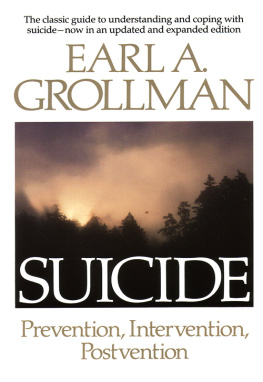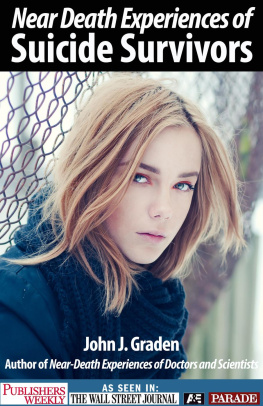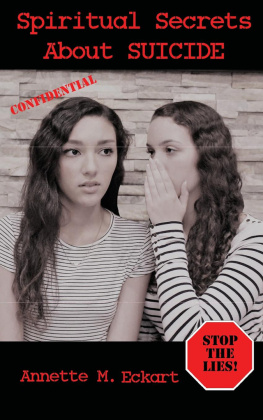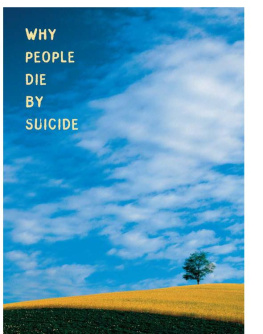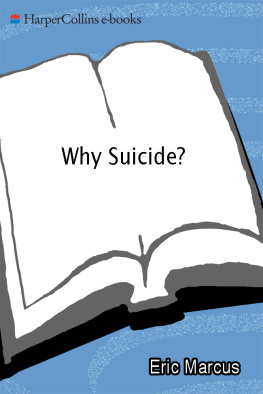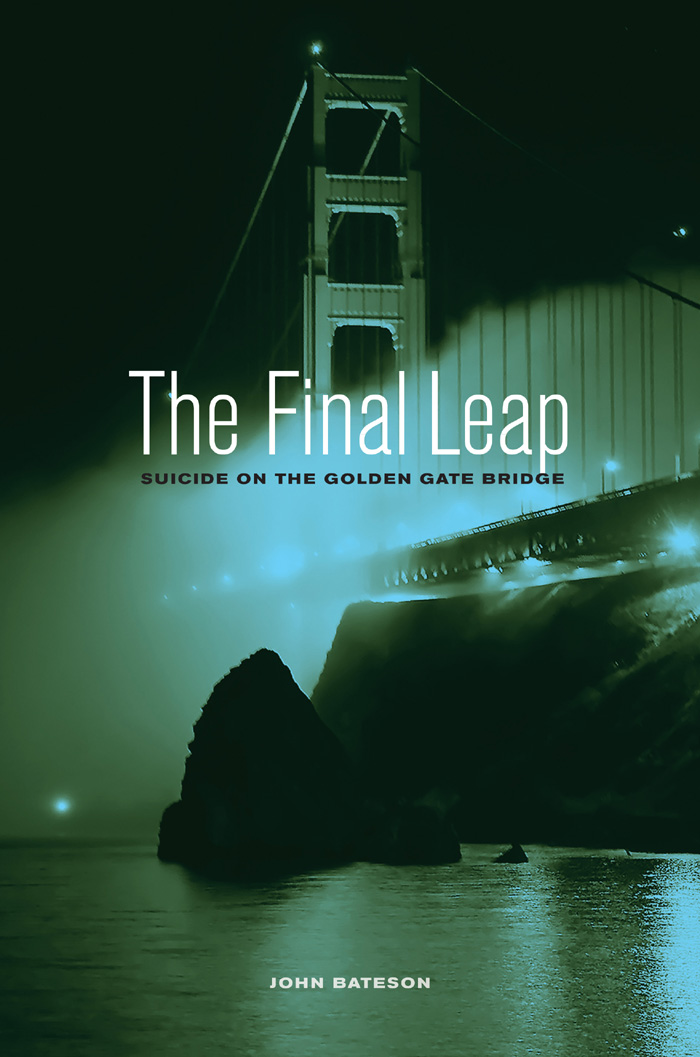The Final Leap
The publisher gratefully acknowledges the generous support of the General Endowment Fund of the University of California Press Foundation.
The Final Leap
Suicide on the Golden Gate Bridge
John Bateson

UNIVERSITY OF CALIFORNIA PRESS
Berkeley Los Angeles London
University of California Press, one of the most distinguished university presses in the United States, enriches lives around the world by advancing scholarship in the humanities, social sciences, and natural sciences. Its activities are supported by the UC Press Foundation and by philanthropic contributions from individuals and institutions. For more information, visit www.ucpress.edu.
University of California Press
Berkeley and Los Angeles, California
University of California Press, Ltd.
London, England
2012 by The Regents of the University of California
Library of Congress Cataloging-in-Publication Data
Bateson, John, 1951
The final leap: suicide on the Golden Gate Bridge / John Bateson.
p. cm.
Includes bibliographical references and index.
ISBN 978-0-520-27240-8 (alk. paper)
1. Suicide victimsCaliforniaSan Francisco.
2. SuicideCaliforniaSan Francisco. 3. Golden Gate Bridge (San Francisco, Calif.) I. Title.
HV6548.U52S36 2012
362.280979461dc23
2011038983
Manufactured in the United States of America
20 19 18 17 16 15 14 13 12 11
10 9 8 7 6 5 4 3 2 1
In keeping with a commitment to support environmentally responsible and sustainable printing practices, UC Press has printed this book on Rolland Enviro100, a 100% post-consumer fiber paper that is FSC certified, deinked, processed chlorine-free, and manufactured with renewable biogas energy. It is acid-free and EcoLogo certified.
To everyone who has lost a loved one
to the Golden Gate Bridge
CONTENTS
ACKNOWLEDGMENTS
First and foremost, I want to thank the family members and friends of Golden Gate Bridge jumpers who shared their stories with me. Some didnt want to be identified or have their stories told so theyre not mentioned. Regardless, my heart goes out to them, and Im sorry for their loss.
A few family members have been public with their grief, knowing that its necessary to influence decision makers and ultimately end suicides from the bridge. It has taken tremendous courage, and it has made a difference. I thank John and Erika Brooks, Dave Hull, Dayna Whitmer, and Mary Zablotny in particular for telling their stories to me and to others.
When friends and colleagues learned that I was writing this book, many wondered how I could sleep at night immersed in so much tragedy. Even tragedies have heroes, I replied, people who refused to be silent, who have stood up for whats right despite being criticized. This book has heroes, too, three in particular. Im speaking of California Assemblyman and former Bridge District board member Tom Ammiano, bridge jump survivor Kevin Hines, and recently retired Marin County coroner Ken Holmes. They will deserve much of the credit when suicides from the Golden Gate Bridge end.
A number of mental health professionals have advocated strenuously over the years in support of a suicide barrier. I thank Mel Blaustein, Anne Fleming, Margaret Hallett, Eve Meyer, Jerry Motto, Richard Seiden, Ron Tauber, and many others for this. In addition to their advocacy, Blaustein and Tauber amassed extensive files of press clippings, meeting minutes, reports, and correspondence regarding suicides from the Golden Gate Bridge, and shared them with me.
Also deserving thanks are Linda Allen, Ken Baldwin, Robert Bea,John Draper, Lorrie Goldin, Eric Hall, Patrick Hines, Thomas Joiner, Dave Kahler, Paul Muller, Nancy Salamy, Eric Steel, Janice Tagart, and Janet Wilson. At various times they served as sources of information and expertise.
Im grateful, too, for the cooperation I received from Golden Gate Bridge District officials. Denis Mulligan, the CEO and general manager, and Mary Currie, the public affairs director, answered every question I asked, as well as provided background information. Kary Witt, the bridge manager, and Lisa Locati, the captain of bridge security, freely answered questions as well.
So did representatives of the U.S. Coast Guard. Leanne Lusk, the sector San Francisco command center chief, and Mark Allstott, commanding officer of Station Golden Gate, made themselves available to talk with me about their work as it pertains to Golden Gate Bridge suicides.
One person I did not interview but who merits acknowledgment nonetheless is Tad Friend. His 2003 article in the New Yorker focused attention on Golden Gate Bridge suicides in a way that hadnt happened before. In some respects he was able to report in 5,000 words what has taken me 70,000.
Locally, the San Francisco Chronicles seven-part series in 2005 about Golden Gate Bridge suicides was among the most in-depth pieces of reporting the paper has ever done. Much of the information is still relevant today, and some of the photos that are reprinted here, with permission, appeared first in the Chronicle.
The staff and board of the Contra Costa Crisis Center also have my gratitude. They provided encouragement and valuable advice throughout the development of this book.
In all likelihood, the final draft would be much different if it had been handled by anyone other than Naomi Schneider and her talented team at the University of California Press. When I decided that there was enough material for a book, and put together a proposal, UC Press was my first choice to publish it.
Writing a book, for the most part, is a solitary process. Other than conducting interviews, the workfrom research to writing to revising of various draftstakes place alone. If one has a family, it means that others have to understand and be supportive. No one could receive more understanding or support than I have from Suzan and our four adult childrenSara, Cassidy, Chlo, and Trevor. You have my love and my thanks.
Prologue
Its a little after 6 A.M. on Tuesday, January 29, 2008. A lone figure walks head down on the Golden Gate Bridge. She is seventeen years old, pretty, with shoulder-length brown hair. In five months shes supposed to graduate from Redwood High School in Marin County, one of the top-rated high schools in California. In the fall, her friends will be heading off to college. She could be heading off to college, too; she has a 3.7 grade point average and has been accepted at Bennington College in Vermont, her first choice. Bennington is a long way from home, which is part of its attraction. Also, its a small collegeanother attraction. She liked the campus when she visited it with her parents, thinking that she would study environmental science and journalism. Now, though, shes on the Golden Gate Bridge, early in the morning on a school day, and has a different plan.
Near the midpoint of the span she stops. No one is around. At this hour of the day, in the middle of winter, it is cold and still mostly dark. The pedestrian walkway is deserted. Theres no one to see her, no one to stop her. She climbs over the railing onto the chord, the 32-inch-wide girder on the other side of the railing. Shes in good shape from playing soccer and lacrosse; however, the railing is only four feet high so being in shape doesnt matter. Almost anyone can climb over it. Between the chord and the dark water of the bay far below is salt air, thick and beckoning.


